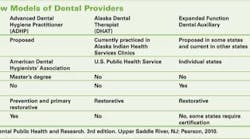by Christine Nathe, RDH, MS
cnathe@salud.unm.edu
I have noticed during the past couple of years that in dentistry, the term midlevel provider has numerous definitions, many of which do not agree with one another or correspond with the existing definition.
We could all agree that in health care at the moment, the term midlevel provider depicts a health-care provider who is a nonphysician, who is educated at least at the Master’s level, and who is responsible for patient treatment. Basically, a midlevel provider is in the “middle” in both academic preparation and scope of practice, between a physician and a registered nurse. Examples of midlevel providers in medicine include nurse practitioners, physical therapists, and nurse anesthetists, to name a few.
At present, dental care does not have a midlevel provider. If we were following the precedent of medicine, a midlevel dental provider would be between a dentist and a registered dental hygienist in both academic preparation and scope of practice.
Although there are many proposed career avenues for dental workers, there is only one proposed provider that meets the accepted definition of a midlevel provider and that is the advanced dental hygiene practitioner. This dental hygienist fits the generally accepted medical definition of a midlevel provider. This provider is educated at the Master’s degree level and assumes the patient’s responsibility at the middle level. Patients who need advanced or specialized care are referred to a general dentist or dental specialist.
Most of the proposed avenues, including dental therapists, expanded duty dental auxiliary, and community dental health coordinator, require no college degree and have different amounts of time for training mandated. Terming these new providers midlevel providers is really using the term loosely, and significantly sets dentistry outside of the academic and practice standards of medicine.
It is important to use generally accepted terms correctly so that all stakeholders entrusted with developing solutions to our dental care issues understand the educational preparation and role of each dental provider. Let us work together to bring new solutions to our dental care issues, without devaluing educational preparation and degree attainment that will diminish the science and practice we consistently promote!
Author’s note: There is an educational program at the University of Minnesota that has an entry-level Bachelor’s program (or Master’s program if the candidate has a baccalaureate degree) for dental therapy.
About the Author
Christine Nathe, RDH, MS, is a professor and graduate program director at the University of New Mexico, Division of Dental Hygiene, in Albuquerque, N.M. She is also the author of “Dental Public Health” (www.prenhall.com/nathe), which is in its second edition with Prentice Hall. She can be reached at cnathe@salud.unm.edu or (505) 272-8147.







